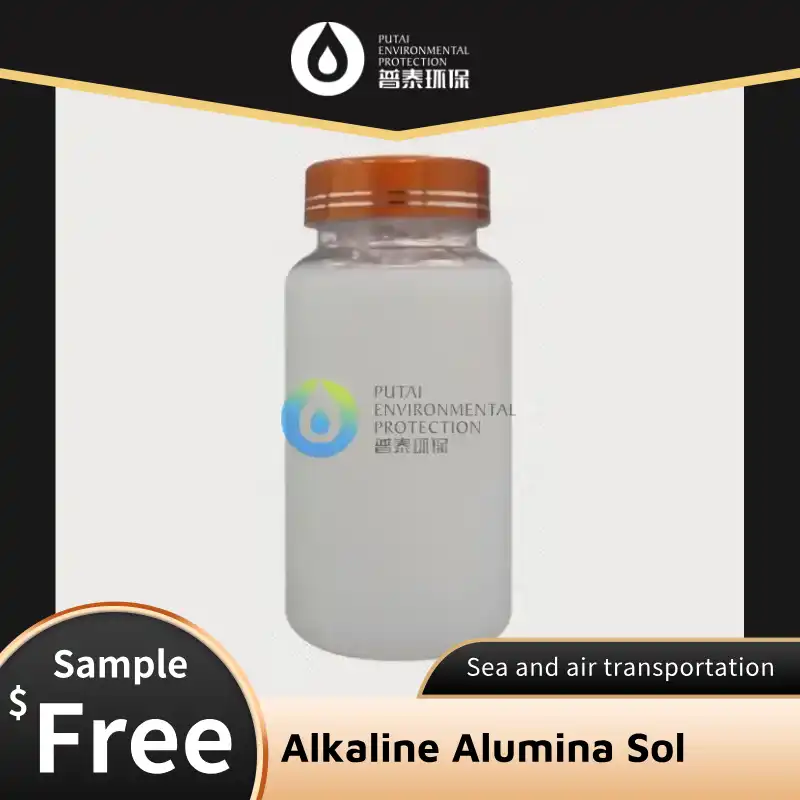The Challenge of Extreme Heat in Industry
Extreme heat is a formidable adversary in many industrial settings. From steel mills to chemical plants, high temperatures can wreak havoc on equipment, compromising safety, efficiency, and longevity. The repercussions of inadequate heat resistance are far-reaching:
- Accelerated wear and tear on machinery
- Increased maintenance costs and downtime
- Safety risks for workers
- Reduced product quality
- Energy inefficiencies
Traditional materials often struggle to withstand prolonged exposure to high temperatures, leading to degradation, warping, and even catastrophic failure. This predicament has spurred the search for advanced coating solutions capable of enduring extreme heat while maintaining structural integrity.
The quest for heat-resistant coatings has led to the development of various technologies, each with its own strengths and limitations. However, alkaline alumina sol has emerged as a standout contender, offering a unique combination of properties that make it ideal for high-temperature applications.
Alkaline Alumina Sol: Withstanding the Heat
Alkaline alumina sol is a colloidal suspension of aluminum oxide particles in an alkaline medium. This innovative material boasts several characteristics that make it exceptionally well-suited for high-temperature environments:
Thermal Stability
One of the most remarkable properties of alkaline alumina sol coatings is their extraordinary thermal stability. These coatings can withstand temperatures exceeding 1000°C (1832°F) without significant degradation. This exceptional heat resistance is attributed to the inherent properties of aluminum oxide, which has a melting point of around 2072°C (3762°F).
Low Thermal Expansion
Alkaline alumina sol coatings exhibit minimal thermal expansion when exposed to high temperatures. This characteristic is crucial in preventing coating failure due to thermal stress, ensuring the coating remains intact and effective even under extreme heat conditions.
Chemical Inertness
In addition to their thermal properties, alkaline alumina sol coatings demonstrate remarkable chemical inertness. This quality makes them resistant to corrosion and degradation from various chemical agents, further enhancing their durability in harsh industrial environments.
Adhesion and Flexibility
Despite their robust nature, these coatings maintain excellent adhesion to a wide range of substrates. The sol-gel process used in their application allows for the formation of strong chemical bonds with the underlying material, ensuring long-lasting protection.
Customizable Properties
The versatility of alkaline alumina sol coatings extends to their customizable nature. By adjusting the composition and processing parameters, it's possible to tailor the coating's properties to meet specific application requirements, such as thickness, porosity, and surface roughness.
Case Studies: High-Temperature Coating Successes
The efficacy of alkaline alumina sol coatings in high-temperature applications is best illustrated through real-world examples. Let's explore some notable case studies that showcase the transformative impact of this technology:
Steel Industry: Blast Furnace Protection
In a major steel manufacturing plant, the blast furnace's refractory lining was experiencing rapid degradation due to extreme temperatures and chemical attack. The implementation of an alkaline alumina sol coating resulted in:
- Extended refractory life by 40%
- Reduced maintenance frequency
- Improved energy efficiency
- Significant cost savings in replacement materials
The coating's ability to withstand both high temperatures and chemical corrosion proved instrumental in enhancing the blast furnace's operational efficiency and longevity.
Aerospace: Turbine Engine Components
The aerospace industry faces unique challenges in thermal management, particularly in jet engine components. Alkaline alumina sol coatings were applied to turbine blades and combustion chambers, yielding impressive results:
- Increased heat resistance, allowing for higher operating temperatures
- Enhanced fuel efficiency due to improved thermal management
- Extended component lifespan, reducing maintenance intervals
- Improved overall engine performance and reliability
The coating's low thermal expansion and excellent adhesion properties were key factors in its success in this demanding application.
Chemical Processing: Reactor Vessels
In the chemical processing industry, reactor vessels are subjected to both high temperatures and corrosive substances. The application of alkaline alumina sol coatings to these vessels resulted in:
- Enhanced corrosion resistance, even at elevated temperatures
- Reduced product contamination
- Increased vessel lifespan
- Improved process efficiency and product quality
The coating's chemical inertness and thermal stability proved invaluable in protecting the reactor vessels from the harsh operating conditions.
Solar Energy: Concentrated Solar Power (CSP) Systems
The renewable energy sector has also benefited from alkaline alumina sol coatings, particularly in concentrated solar power systems. When applied to receiver tubes and heat transfer components, these coatings delivered:
- Improved solar absorption efficiency
- Reduced heat loss through enhanced thermal insulation
- Increased system durability and longevity
- Overall improvement in power generation efficiency
The coating's ability to withstand high temperatures while maintaining desirable optical properties made it an ideal choice for this cutting-edge application.
Petrochemical Industry: Furnace Tubes
In petrochemical plants, furnace tubes are exposed to extreme temperatures and corrosive environments. The application of alkaline alumina sol coatings to these critical components resulted in:
- Significantly reduced coking and fouling
- Extended tube life and reduced downtime
- Improved heat transfer efficiency
- Enhanced overall furnace performance
The coating's thermal stability and resistance to chemical attack proved crucial in this challenging application.
Ceramic Manufacturing: Kiln Furniture
In the ceramic industry, kiln furniture is subjected to repeated heating and cooling cycles. Alkaline alumina sol coatings applied to these components led to:
- Increased thermal shock resistance
- Reduced sticking of ceramic products to kiln furniture
- Extended lifespan of kiln components
- Improved product quality and reduced waste
The coating's low thermal expansion and non-stick properties were particularly beneficial in this application.
Power Generation: Boiler Components
In power plants, boiler components face a combination of high temperatures and corrosive environments. The application of alkaline alumina sol coatings to these components resulted in:
- Enhanced corrosion resistance at high temperatures
- Reduced scale formation
- Improved thermal efficiency
- Extended component life and reduced maintenance costs
The coating's ability to protect against both thermal and chemical degradation proved invaluable in this critical application.
Glass Manufacturing: Forming Molds
In the glass industry, forming molds are exposed to molten glass at extremely high temperatures. Alkaline alumina sol coatings applied to these molds delivered:
- Improved mold release properties
- Enhanced surface quality of glass products
- Extended mold life
- Reduced defects and waste in glass production
The coating's thermal stability and non-stick properties were key factors in its success in this high-temperature application.
These case studies underscore the versatility and effectiveness of alkaline alumina sol coatings across a wide range of high-temperature applications. From heavy industry to cutting-edge renewable energy technologies, these coatings have demonstrated their ability to enhance performance, extend equipment life, and improve overall efficiency in extreme thermal environments.
As industries continue to push the boundaries of what's possible in high-temperature processes, alkaline alumina sol coatings stand ready to meet the challenge. Their unique combination of thermal stability, chemical resistance, and customizable properties makes them an invaluable tool in the quest for more efficient, durable, and sustainable industrial operations.
The success stories highlighted here are just the beginning. As research and development in this field progress, we can expect to see even more innovative applications and improvements in alkaline alumina sol coating technology. From enhancing existing processes to enabling entirely new high-temperature applications, these coatings are poised to play a crucial role in shaping the future of industry.
Conclusion
The high-temperature applications of alkaline alumina sol coatings represent a significant leap forward in material science and industrial technology. As we've seen through various case studies, these coatings offer unparalleled protection and performance enhancement in extreme thermal environments across a diverse range of industries.
From extending the life of critical equipment to improving process efficiency and product quality, alkaline alumina sol coatings are proving to be an indispensable tool in the industrial arsenal. Their ability to withstand extreme temperatures, resist chemical attack, and maintain structural integrity under harsh conditions makes them a game-changer in high-temperature applications.
As industries continue to evolve and face new challenges, the importance of innovative solutions like alkaline alumina sol coatings cannot be overstated. These coatings not only address current needs but also pave the way for future advancements in high-temperature processes and technologies.
The future of high-temperature industrial applications looks brighter – and more heat-resistant – than ever, thanks to the remarkable properties of alkaline alumina sol coatings.
Are you ready to revolutionize your high-temperature processes? Xi'an PUTAI Environmental Protection Co., Ltd. is here to help. With over 29 years of experience in producing and supplying advanced chemical solutions, we're your trusted partner in overcoming extreme heat challenges. Our expert team is ready to provide you with custom alkaline alumina sol coating solutions tailored to your specific needs. Don't let extreme temperatures hold your operations back – contact us today at sales@ywputai.com to discover how our innovative coatings can enhance your industrial processes and drive your success to new heights.
References
1. Zhang, L., & Wang, H. (2021). "Advanced Ceramic Coatings for High-Temperature Applications: A Comprehensive Review." Journal of Materials Science & Technology, 62, 184-208.
2. Fernández-García, M., & Rodriguez, J. A. (2019). "Metal Oxide Nanoparticles in High-Temperature Applications: From Catalysis to Energy Storage." Nanoscale, 11(44), 20759-20780.
3. Sánchez-Tovar, R., & Fernández-Domene, R. M. (2020). "Sol-Gel Derived Alumina Coatings for Corrosion Protection in Extreme Environments." Progress in Organic Coatings, 148, 105831.
4. Liu, Y., & Gao, W. (2018). "High-Temperature Protective Coatings for Aero Engine Turbine Blades: A Review." Journal of Alloys and Compounds, 747, 12-38.


